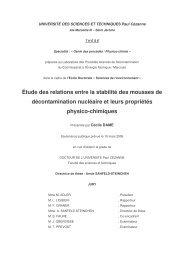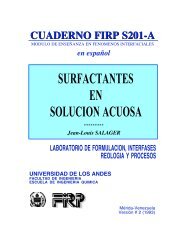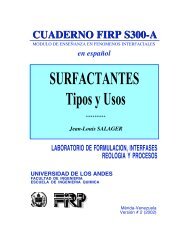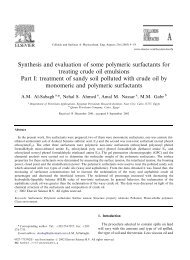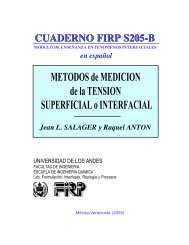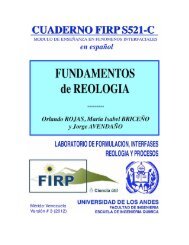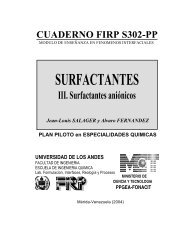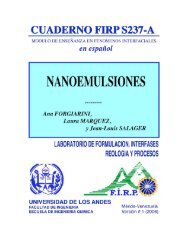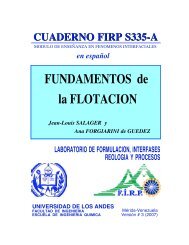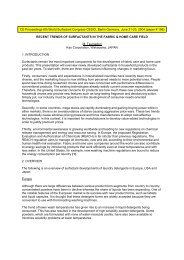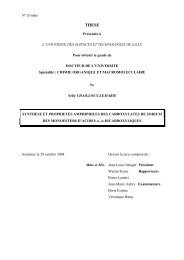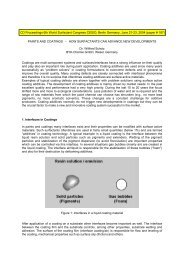Solubilization-emulsification mechanisms of detergency
Solubilization-emulsification mechanisms of detergency
Solubilization-emulsification mechanisms of detergency
Create successful ePaper yourself
Turn your PDF publications into a flip-book with our unique Google optimized e-Paper software.
C.A. Miller and K.H. Raney/Colloids Surfaces A: Physicochem. Eng. Aspects 74 (1993) 169-215 173<br />
Fig. 2. Phase diagram <strong>of</strong> C 12E 5-water system [21]. L 1,<br />
L 2, and L 3 denote isotropic liquids; Lα, H 1, and V 1<br />
denote lamellar, hexagonal and viscous isotropic<br />
liquid crystalline phases, respectively. Reprinted with<br />
permission <strong>of</strong> the Royal Society <strong>of</strong> Chemistry.<br />
relatively low surfactant concentrations. As the<br />
particles <strong>of</strong> a liquid crystal do not coalesce as<br />
readily as liquid drops, the dispersions <strong>of</strong> La are<br />
frequently less turbid than those <strong>of</strong> L 3, a<br />
property which can be used to locate phase<br />
transition temperatures at which the La and L 3<br />
phases form [22]. At the highest temperatures<br />
shown in Fig. 2 the surfactant-rich liquid phase<br />
L 2 coexists with water.<br />
For more hydrophilic surfactants such as<br />
n-dodecyl hexaoxyethylene monoether (C 12E 6),<br />
clouding occurs at higher temperatures.<br />
Moreover, the Lα and L 3 phases do not appear<br />
at low surfactant concentrations; the La phase<br />
transforms continuously into L 2, and the cloud<br />
point curve is the only feature <strong>of</strong> this part <strong>of</strong> the<br />
phase diagram (see Fig.3). Phase diagrams for<br />
various binary nonionic surfactant-water<br />
systems are given by Mitchell et al. [23].<br />
Temperature effects are weaker for ionic<br />
surfactants and generally act in the opposite<br />
direction. Since the Debye length, a measure <strong>of</strong><br />
the electric double layer thickness, is<br />
proportional to (kT) 1/2 , where kT is the<br />
characteristic free energy <strong>of</strong> random thermal<br />
Fig. 3. Phase diagram <strong>of</strong> C 12E 6-water system [23].<br />
The symbols for the phases are as in Fig. 2 except<br />
that S is a solid phase and W is a water-rich liquid<br />
phase. Reprinted with permission <strong>of</strong> the Royal<br />
Society <strong>of</strong> Chemistry.<br />
motion, higher temperatures make ionic<br />
surfactant films more hydrophilic, with a greater<br />
tendency to curve toward an oil-in-water<br />
configuration. However, the addition <strong>of</strong><br />
inorganic salts has the opposite effect,<br />
compressing electric double layers and causing<br />
ionic surfactant films to become less<br />
hydrophilic. In some cases, a- second liquid<br />
phase is ultimately formed as salinity increases,<br />
i.e. the behavior is similar to clouding <strong>of</strong><br />
non-ionic surfactant solutions discussed above.<br />
This phenomenon was observed by McBain<br />
many years ago for aqueous soap solutions<br />
[23b]. Another example is shown along the<br />
upper boundary <strong>of</strong> Fig. 4 [24], with NaCl added<br />
to the sodium salt <strong>of</strong> a commercial ethoxylated<br />
sulfate based on a C 12-C 13 alcohol and<br />
containing an average <strong>of</strong> three ethylene oxide<br />
groups (Neodol 23-3S). As Fig. 4 indicates,<br />
multiphase regions involving the lamellar liquid<br />
crystal La are observed at even higher salinities.<br />
In other systems, for instance the Aerosol<br />
OT-NaCl-water system, the first phase formed<br />
upon increasing the salinity is the lamellar liquid<br />
crystalline phase [25,26]. Indeed, such behavior<br />
is typical for anionic surfactant-short-chain<br />
alcohol systems investigated for possible use in



